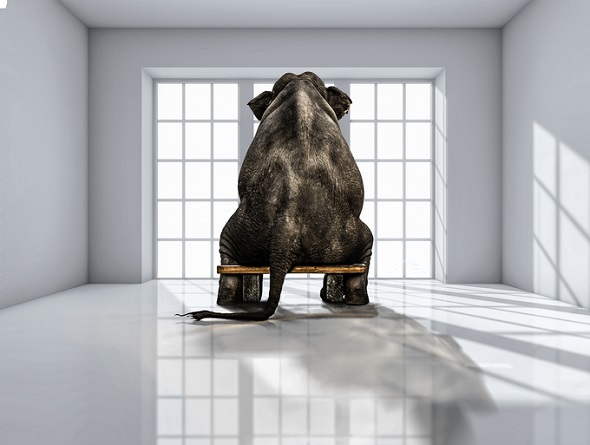“Elephant in the room is an English-language metaphorical idiom for an obvious problem or risk no one wants to discuss, or a condition of groupthink no one wants to challenge.”
– Wikipedia
The first elephant in the room is pleasure. How much exactly are we allowed to have in America? By what means? Who’s allowed to have it? And how do we decide what’s enough and what’s too much and what’s a no-no altogether?
What’s a “nice high” and a “not nice high”? I get a nice high from exercise and fine food. I used to get a buzz from alcohol but I currently abstain. My dad’s in the room, so I won’t elaborate, but I get a nice high from sex with a fine partner. I get a buzz from caffeine.
If I were in Denver, it would be legal to get a nice buzz, a nice high from marijuana. Very same high, transported to Montgomery County, Virginia? Why, people get their children taken away from them for using marijuana in our neck of the woods. Is it because they’re having a “not nice high”?
Another elephant in the room is pain. How much exactly are we supposed to be able to bear on our own? Who deserves immediate pain relief, who needs to “tough it out,” and how do we decide? Does emotional pain count? Just physical pain? What’s okay to do to lessen pain? What’s not okay?
When I see a child crying in pain – and you know that sound that’s different from distress – there’s a helplessness to it that’s heartrending. I want to do anything I can, as fast as I can, to relieve that child’s pain. I remember when I was a child and fell, my mother would say, “Put ice on it!” We don’t think little kids should have to be in any pain.
What about adults, though? Men are told, “Big boys don’t cry”? Women are told, “Never let ’em see you cry.” Should a little old lady riddled with cancer at Warm Hearth be given pain meds? Should a roofer whose co-worker accidentally knocks him off a ladder be given pain meds after his back surgery? Should a teenaged girl who’s being sexually assaulted by her mother’s boyfriend be allowed to have a couple of beers and smoke a joint with her friends?
Our beliefs about pleasure and pain provide the context for understanding our beliefs about the use of substances to bring us pleasure and ease our pain.
I was asked to speak on the “opioid epidemic” and what we can do about it. According to the Centers for Disease Control (CDC), an epidemic is “an increase, often sudden, in the number of cases of a disease above what is normally expected in that population in that area.”
If you Google “opioid epidemic,” even among credible sources, you’ll find a confusing collection of terms: opioid crisis, opioid use, opioid abuse, opioid misuse, opioid dependence, opioid use disorder, opioid addiction, opioid overdose.
Which of these differently defined terms related to the “opioid epidemic,” exactly, are we upset about? And about which “opioid” are we talking? Prescription opioids for pain patients, heroin, street fentanyl, manufactured in clandestine labs?
According to the CDC, the number of people dying per day due to opioid overdose – with “opioid” defined all inclusively – is 91. That is a tragic number. From the effects of cigarette smoking, 1,300 people die each day. What orders of magnitude are we using to decide what’s upsetting us?
Are we upset about pleasure? Two-thirds of people with substance use disorders have experienced trauma. Half have a mental illness. They’re having fun, right?
Are we upset about pain? Do we think people should not have opioids for pain because they might become addicted to them?
- The vast majority of people who try alcohol and other drugs do not become addicted to them.
- 92% of people exposed to prescription opioids do not become addicted to them.
- 96% of those who do become addicted to prescription opioids do not shift to heroin.
- Since 2012, prescriptions for opioids are down.
- Since 2011, overdose deaths from prescription opioids alone are down.
- In 2015, a third of new opioid users began with heroin.
- According to the CDC, the increase in opioid-related deaths between 2013 and 2016 “is primarily due to fentanyl.” Fentanyl is not a component of prescription opioids.
- Most overdose deaths, including opioid-related deaths, involve more than one drug, including alcohol. 97% of overdose deaths in NYC in 2016 involved more than one drug.
- Over 2 million Americans are estimated to have opioid use disorder.
- Over 16 million Americans are estimated to have alcohol use disorder.
Does the data support the term “opioid epidemic”?
Why are we cutting off opioid pain meds for chronic pain patients? Is it time for them to “tough it out”? Better they suffer before they die rather than allow for the extremely remote possibility they might be one of the 8 in 100 who develops an addiction to opioids from prescription pain meds?
I don’t know the answers to these questions.
But we’ve let the poor elephants free. Data is in the room now.
. . .
This post is the first half of an expanded version of a talk on the opioid epidemic for the Montgomery County, Virginia Democratic Party I gave on 8/17/17. The second half is here.
Last updated 11/18/17
The opinions expressed are mine alone and do not necessarily reflect the positions of my employers, co-workers, clients, family members or friends. This content is for informational purposes only and is not a substitute for medical or professional advice. Consult a qualified health care professional for personalized medical and professional advice.


